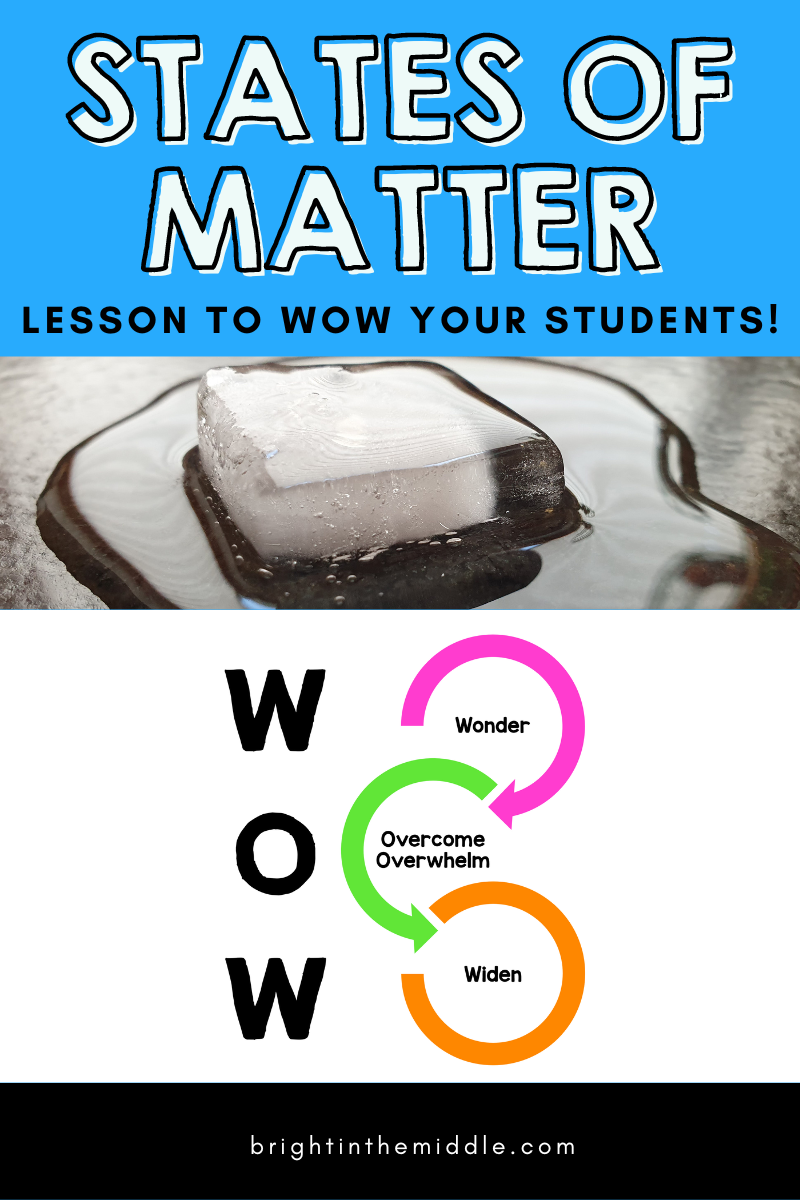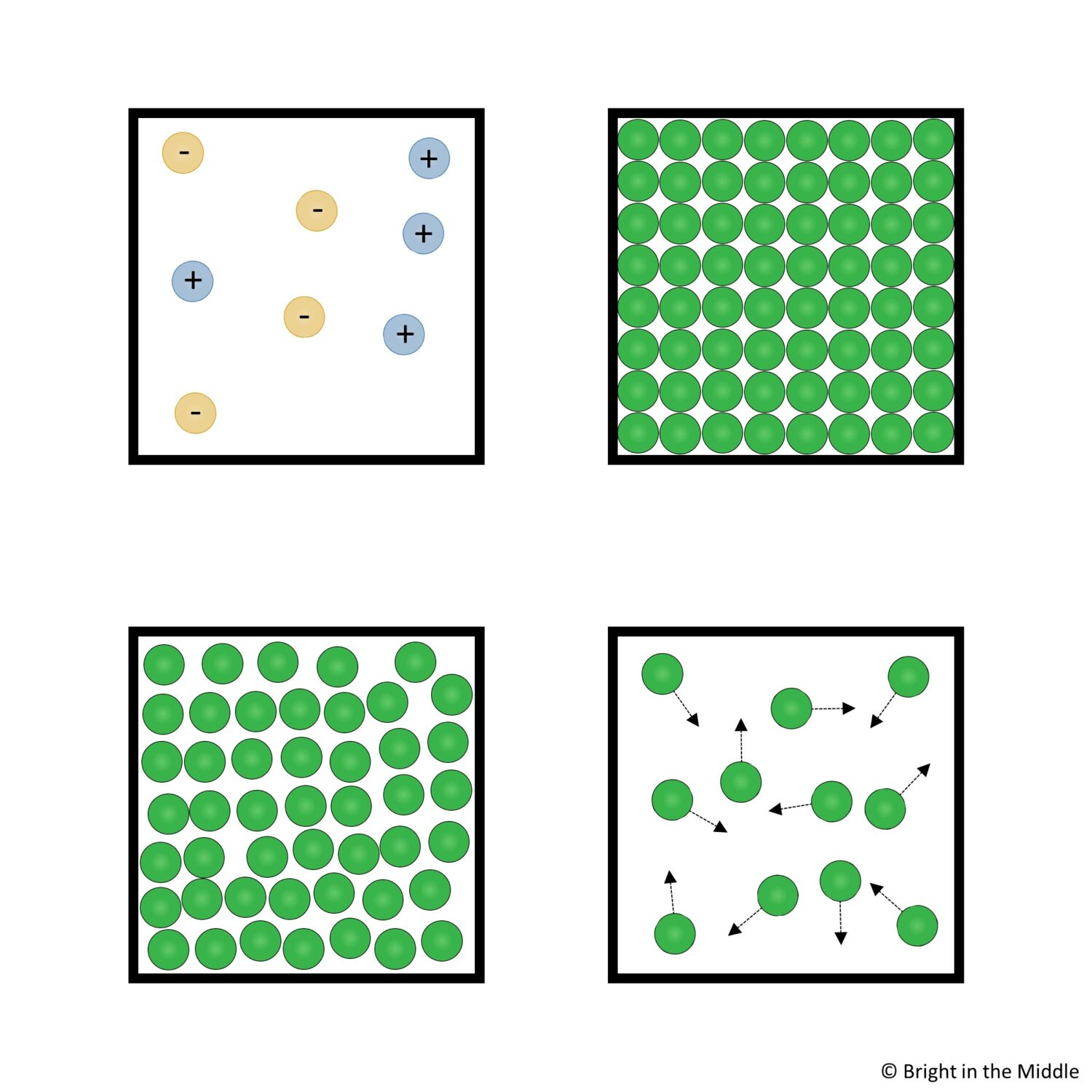Working on creating lesson plans on states of matter for your middle school classroom? Something so simple can be challenging to engage your students in. It may seem easy, but it is more of an abstract concept. Students see solids, liquids, gases, and even plasma; however, they don’t see them at a microlevel that makes them the way that they are!
Matter makes up everything, and the state of matter is dependent on several things dealing with particles: the arrangement, the attractions, and the amount of energy.
The particles in matter are always in motion, even in solids.
To get students excited about learning about what states of matter are and the difference between them all, you can use the WOW factor! Many ideas can be used for your lesson plan, and even a 5E lesson plan on states of matter.
First, I will share some WONDER strategies. These are the strategies that will get your students internally motivated to learn more about the states of matter. Second, I will share a states of matter lesson that is interactive and engaging for your students. It will help them OVERCOME OVERWHELM and better retain the information. Finally, I will share some ideas that you can use so that your students can WIDEN their knowledge on this topic!
There are a lot of ideas for teaching states of matter!

WONDER Strategies to Add to Your Lesson Plan about States of Matter
In all of my WOW Factor lessons, I’m sure to include wonder strategies. These are strategies that activate students’ prior knowledge, are engaging, have them wondering, and help them want to learn even more.
Here are two simple wonder strategies that you can use to start off this lesson!
States of Matter Walk Around
By middle school, most students have heard about the states of matter: solids, liquids, gases, and maybe even plasma. This is a great activity you can do to activate prior knowledge, see what they already know, and just get them engaged in learning more!
Remind them of all of the states of matter. They may not know too much about plasma, but mention it too!
Set up different items around the room. Have students to identify them as a solid, liquid, gas, or plasma as they observe them.
Here are some examples of the items you can have around the room:
Solids
- chair
- bread
- ice
- book
- hat
- toys
- wood
- cell phone
Liquids
- water
- soap
- lotion
- vegetable oil
- mouthwash
- milk
- baby oil
Gases
- a Ziplock bag of air
- hairspray
- balloon
Plasma
- neon Sign
- fluorescent light bulb
For fun, you can also make some Oobleck! This is a non-Newtonian fluid that exhibits properties of both liquids and solids.
After students have identified these items as a state of matter, discuss them as a class. See what discrepancies they have. They may say that the neon sign is solid, and there are parts that are. Discuss it. They may say hairspray is a liquid. Have those important discussion on how it can be considered both a liquid and a gas. There are so many things to explore!
Show Students Diagrams
This activity will pair well with the previous wonder strategy, but it can also stand on its own!
What should you do? Show your students a diagram of the particles of each state of matter – NOT LABELED – and have them guess what each one represents and why.
This will really give you a chance to see what they already know!
Here’s an example of what you can show them! Don’t forget to ask why they think each picture is what they guess!

The States of Matter Lesson and Activity
Now your students are ready to learn more! Using this interactive lesson will help students to learn more information about solids, liquids, gases, and plasma without overwhelming them. If students learn too much information at a time, they will end up not learning anything at all. That’s why I created interactive lessons.
Interactive lessons break information into digestible pieces, making it easy to understand and allows students to process. These lesson use many steps to help students retain information like a rockstar.

This states of matter interactive lesson is the way to go. It covers matter, what states of matter are dependent on, solids, liquids, gases, and plasma characteristics and examples, and more!
There are interactive activities embedded along the way including a KWL, drag-and-drop activities, exploring outside resources, typing the text box to answer questions, and more.
It can be used as a states of matter online activity or for direct instruction!
This resource can be found in the Bright in the Middle Shop.
WIDEN Strategies to Add to Your States of Matter Lesson Plan
Looking to expand your students knowledge a little more? I’m all for it! Here are some next step widening strategies.
Solid, Liquids, Gases, and Plasma Class Model
This is a fun activity to get students thinking. Split your class into four groups. Each group will be assigned to represent a solid, liquid, gas and plasma with only themselves! They can be as creative as they want.
Here are some examples of what you may see.
- Solid: Students stand closely together in pattern and shake just a little bit.
- Liquid: Students stay close together but are in no particular arrangement. They flow and slide past each other.
- Gas: Students are separated, don’t touch, and move quickly!
- Plasma: Students move about and say both positive and negative things!
Don’t have enough students in a group? You can have the whole class try and represent each one!
Jump into Changing States of Matter
Don’t have time to spend on learning more about the states of matter characteristics? Go ahead and move into phase changes! There is a lot to explore there! There are a lot of easy states of matter experiments to dive into!
The WOW Factor can easily be placed into a 5E lesson plan – states of matter, or any lesson plan for that matter!
Help your students master science content!



[…] States of Matter […]